 GRADE CROSSINGS
GRADE CROSSINGS |
|
CROSSBUCKS - DIAMOND SIGNS |
|
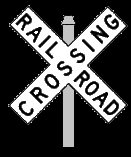 As
America became laced with railroads in the latter half of the 19th
century, it soon became apparent that safety warning signs and signals
should be set up to protect people who wanted to cross the tracks.
Initially, a variety of signs were posted at crossings, and in time,
watchmen were stationed at the busier crossings to warn of approaching
trains. As
America became laced with railroads in the latter half of the 19th
century, it soon became apparent that safety warning signs and signals
should be set up to protect people who wanted to cross the tracks.
Initially, a variety of signs were posted at crossings, and in time,
watchmen were stationed at the busier crossings to warn of approaching
trains.
The first U.S. patent given for a railroad crossing gate dates back to
August 27, 1867, and was awarded to J. Nason and J. Wilson of Boston
Massachusetts. At that time, crossing gates were hand-operated by
means of a crank mechanism. The gates were lowered and raised by means of
cables or chains running through underground piping from the gatekeeper's
crank base to each individual gate at the crossing. Generally, each
crossing had four separate gates. Due to the extreme length and great
weight of the wooden gates, they had to be counterbalanced by very heavy
cast-iron weights at their bases. Snow or rain could cause the wooden
gates to become even heavier than they normally would be. Additional
weight could be added to the massive counterweights as needed by the
gatekeeper, who would place cast-iron disks, each weighing approximately
20 – 30 pounds apiece. As a train approached, the gatekeeper would crank
the gates, and these would remain down until the train passed safely.
By the early 20th century, the use of "crossbuck" signs (the boards
forming an "X"), were very common. The design formed the basic warning
sign still in use today, but vastly improved with automatic warning
advances. In the mid-1920s, sign makers began using road reflectors called
Cataphote reflectors or “cats eyes” on crossbuck signs to make them more
visible to drivers at night. These were used through the mid-1940s, when
reflective buttons became common. Eventually, reflective sheeting gained
popularity. Today, the material is still used to make street and railroad
crossing signs.
Since it wasn't practical to have employees stationed at all railroad
crossings, a way was sought to automatically alert the public that a train
was approaching.
The first automatic crossing signals were bells mounted atop poles. They
were activated when a train entered a circuit where the rails were
insulated to confine the electric current to a designated piece of track.
The current flowed through the steel wheels and axles of the train,
short-circuiting electricity to a relay which needed the power to hold the
electrical connection apart that kept the bell off. When the electricity
was diverted through the train...(which was a path of lower
resistance)...instead of the relay connection, the contacts connected and
the bell rang.
The electric bell idea was quickly expanded to include a swinging round
sign with a red light hanging from an arm on the signal pole to simulate a
flagman waving a red lantern. The "Automatic Flagman" signals were soon
dubbed "Wig-Wags". Only a very few Wig-Wags remain in use today in the
United States, much beloved by rail enthusiasts for their nostalgic
warning. One historic Wig-Wag signal from the early-1930's (formerly in
use on the Susquehanna Railroad just West of Butler, NJ) is currently
being restored for operation at the Whippany Railway Museum.
Eventually the Wig-Wags gave way to the alternating flashing red lights
mounted as part of a cross-buck sign, and often with the crossing gates as
well. The first flashing red light signal was installed in New Jersey in
1913.
At the Museum site, a fully-functional 1940's-era Crossing Flasher from
the Central Railroad of New Jersey warns visitors of approaching excursion
trains. With it's twin flashing red lights, cast-iron crossbucks and
warning bell, the signal is a classic example of mid-20th Century grade
crossing protection.
Today the basic designs come in a wide variety of configurations,
depending on the complexity of the street crossing and the railroad
company. Each one is custom designed to fit a specific need.
Originally, wooden crossing gates protected the entire width of the
roadway. But in the later-half of the 20th Century, most crossing gates
were re-designed to protect against motor traffic only in the oncoming
lanes...covering only half the street, allowing an "escape" from the
tracks for motorists who happened to be on the crossing when the signal
was activated. Crossing Gates - South Amboy NJ 1981
With a terrifying number of motorists increasingly ignoring the crossing
gates and winding up being involved in a deadly accident, the use of "four
quadrant gates" currently is being implemented around the country to
prevent motorists from driving around lowered gates.
In addition to the signals and signs, operating rules require train crews
to sound the locomotive horn or whistle a quarter of a mile in advance of
each public crossing until they cross the roadway. Modern locomotives are
equipped with a triangle of bright headlights, one mounted high and
centered, and two on each lower side of the front of the engine. As soon
as the horn begins to sound, the lower twin lights are illuminated and
flash alternately.
Since physics makes it impossible to stop a moving train in time to avoid
striking a motorist or pedestrian on the track by the time the train crew
realizes the danger, the public must always take extreme care when
approaching railroad tracks. It takes more than half a mile to stop a
heavy freight train, even when emergency braking is used. Signals,
signs, lights, whistles and horns are important safety aids, but
ultimately it is the motorist's responsibility to determine whether or not
it is safe to cross the tracks. Source: The Whippany Railway
Museum, P.O. Box 16, Whippany, NJ 07981 (973) 887-8177
|
_small.jpg)
Atlanticville at Lewis Road c. 1885
(Brainerd-Huneke)
railroad crossing
look out for the cars

Flushing & North Side 58th St & 38th Ave.
Woodside Station (photographer unidentified)
c. 1872 Archive: Dave Keller |
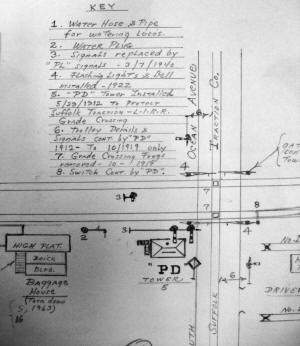
Emery PD Tower, Patchogue 5/1958
(SUNY Stony Brook-Emery)PD
Tower 5/29/1912 to protect Suffolk Traction/LIRR Grade Crossing
Derails & Signals controlled by PD 1912-10/1919
Grade Crossing Flags removed 10/1919
Flashing Lights & Bell installed 1922
Position Light Signals installed 3/07/1940
|
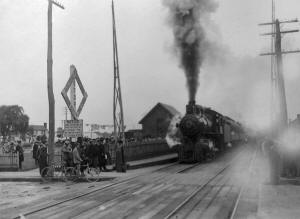
Patchogue Special LIRR #217 Ocean
Ave. View W 10/15/1906 (Howard S. Conklin-LI collection, Queens Borough
Public Library)"Special" train
at Patchogue Station while Senator Charles Evans Hughes delivers a
campaign speech for the US Presidency from the rear observation car. He
lost and later became a Chief Justice of the Supreme Court. LIRR #217 and
the two car train view west from South Ocean Ave. crossing. 10/15/1906 |
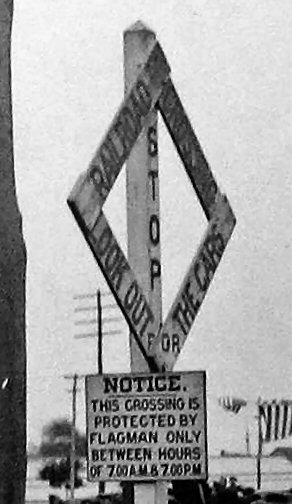 |

Peconic Lane grade crossing after a large snowfall
in Peconic, ca. 1898. Perhaps this photo was taken after the
famous Portland Gale blizzard that ravaged Long Island and most of New
England November 26th-27th of 1898. Info: Chris Klug Photo:
Josiah C. Case Archive: Queens Public
Library
|
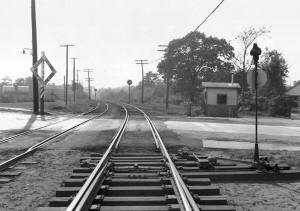
River Ave., Patchogue 10/1943 (Weber-Keller) |
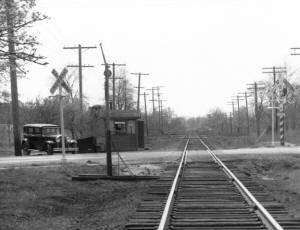
South Country Rd., Patchogue view W of
crossbuck, diamond sign, warning bell, and crossing shanty.
4/24/1946 (Fred Weber photo, Dave Keller archive) |
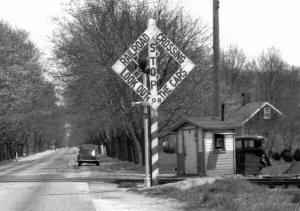
South Country Rd., Patchogue view S of diamond sign,
warning bell, and crossing shanty. 4/24/1946
(Fred Weber photo, Dave Keller archive) |
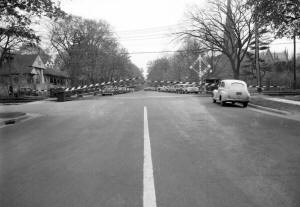
Cathedral Ave., Garden City diamond sign and
gates - View S (Weber-Morrison)
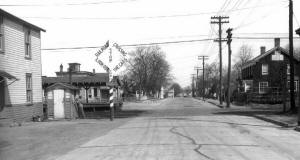
Railroad Ave., Patchogue - Diamond sign and
crossing shanty - View N 5/1943
(Fred Weber photo, Dave Keller archive) |
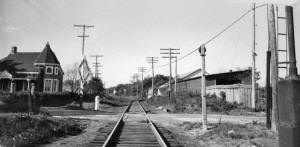
Grove Ave., Patchogue - Diamond sign and
warning bell View W at MP54
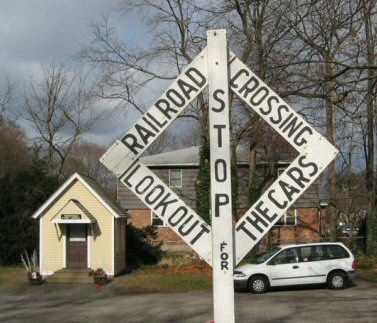
Diamond crossing sign -Wantagh Museum 12/04/2007 Photo/Archive: Al
Castelli |
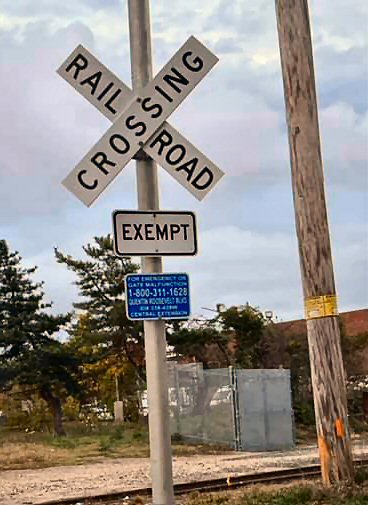
Charles Lindbergh Blvd - Mitchell
Field, Garden City secondary - EXEMPT
crossbuck crossing Photo/Archive: Hank Krumholz |
Exempt signs are intended to inform
drivers of commercial motor vehicles transporting passengers or hazardous
materials that a stop is not required at certain designated railroad
crossings, except when rail traffic is approaching or occupying the
crossing or the driver's view is blocked. |
| |
CROSSING GATES |
|
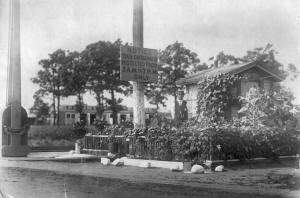
Railroad Crossing sign: NOTICE: This crossing is
protected from 7 A.M. to7 P.M. Only - Windsor Ave. and Union
Blvd, Brightwaters c.1910's
Archive: Patrick Valdini |

Carleton Ave., Central Islip Pole Gates c.1918
(George G. Ayling photo, Dave Keller archive)
|
%20-%2007-27-1930_Sperr-Keller_small.jpg)
DO NOT CROSS TRACKS
USE SUBWAY
Elevated Crossing Gate Tower - Autumn Ave., Brooklyn station - View
SE 7/27/1930 (Sperr-Keller)
Note: A pedestrian underpass below track grade. |
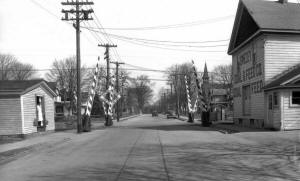
Rider Ave., Patchogue - Gates and diamond signs
View N 5/1943
(Fred Weber photo, Dave Keller archive) |
|
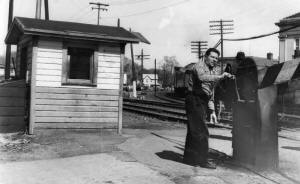
Watchman lowering crossing gates at Broadway St., Hicksville 1959 Archive:
LIRR/MTA
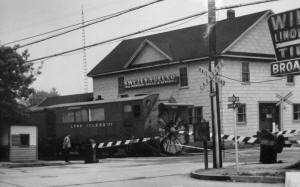
Rider Ave., Patchogue - Gates and crossbucks
View SE 1968 Archive: Ron Ziel |
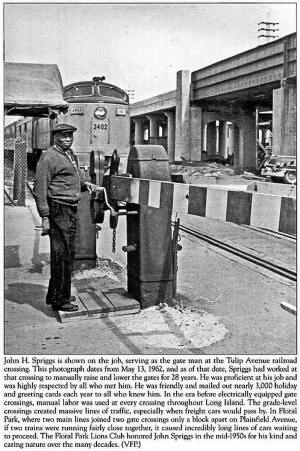
Tulip Ave., Floral Park - John H. Spriggs 5/13/1962 Archive: Sal Bonagura |
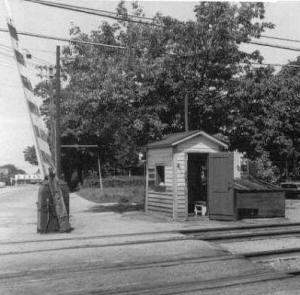
Rider Ave., Patchogue Crossing shanty and gates
View N 1968 Photo/Archive: Dave Keller
|
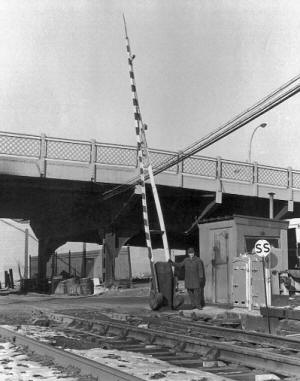
Greenpoint Ave., Blissville crossing shanty and
gates 12/1970 Photo/Archive: Dave Keller
|
| |
SIGNAL LIGHTS |
|

Medford Road (later Rte. 112), Medford - Center island concrete stanchions
for railroad crossing flashing lights. View NE 11/10/1932 (Hart
photo for the Public service Commission, Courtesy of Art Huneke) |
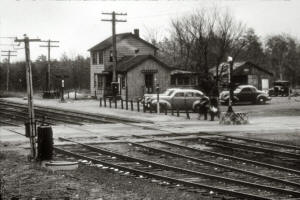
The signal mast and semaphore block signals have
been removed (sometime after February 26, 1939) and replaced with “MD”
block limit signals only. View is a close-up. Archive: Dave Keller |

Lefferts Blvd. view S at Atlantic Ave. concrete stanchions crossing
signals and crossing gates 5/07/1935 zoom - Archive: Kevin Katta |
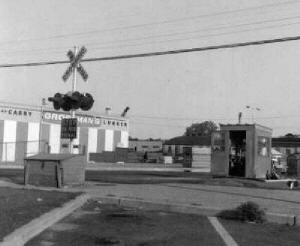
West Ave., Patchogue - Crossing lights and
replacement shanty view NW 1968
Photo/Archive: Dave Keller |
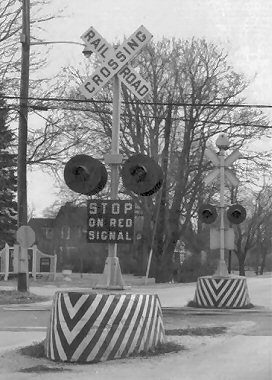
Center Island concrete stanchions crossing signal Bayport Ave., Bayport
view S 1971
Photo/Archive: Dave Keller |
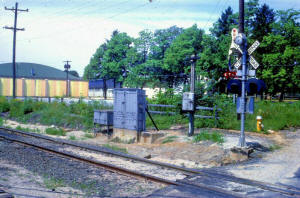
Landing Ave., Smithtown - Wooden relay case,
call box, crossing signal, and bell - 8/1963
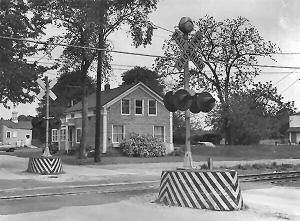
Bayport Ave., Bayport view N prior to removal of
crossing signals on 10/07/1974.
6/06/1972
Photo/Archive: Richard Eikov |
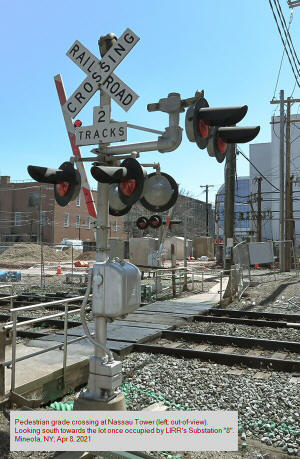
NASSAU Tower pedestrian grade crossing signal
View S 4/08/2021 Photo/Archive: Ed Frye |
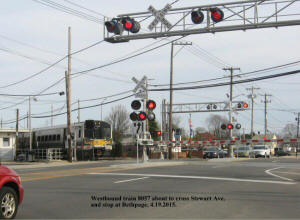
Stewart Ave., Bethpage cantilever quadrant gated signal lights Train #8057
westbound 4/19/2015
Photo/Archive: Joe McMahon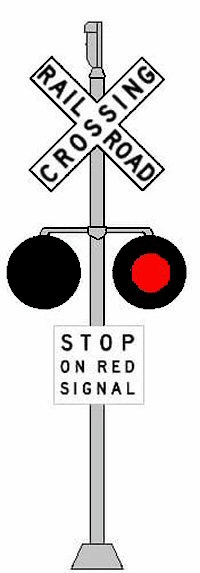
|
| |
GRADE CROSSING CRASH POSTS |
|
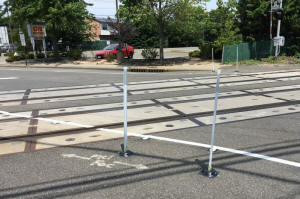
Broadway, Bethpage - West side close-up
View NE 6/06/2018 Photo/Archive: Al Castelli |
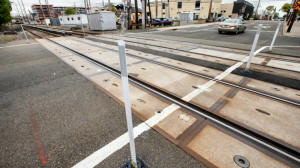
Willis Ave., Mineola grade crossing crash posts
5/15/2018 Newsday-Howard SchnappTermed
delineators affixed to flexible "breakaway" mounts to allow quick and easy
replacement and will not
physically prevent a vehicle from entering the
track area. They exist only to inform motorist that the lane continues
over the grade crossing; it’s an effort to prevent drivers from turning
onto the tracks.
Mike McEnaney |
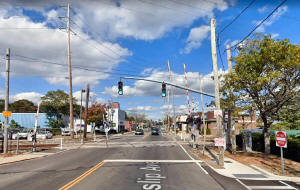
Islip Ave., Islip - Pre-Signal grade crossing with crash posts View N
10/2021 Google mapsNote: Pre-Signal with
Displaced Stop Line
double-track crossing. Used to manage parallel to the tracks side
street traffic (in this case the Islip Station parking lot). |
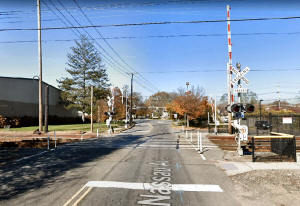
Nassau Ave., Islip grade crossing crash posts
View N - 2022 Google maps
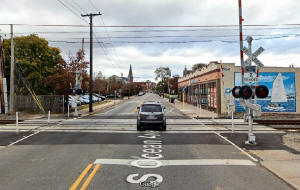
Ocean Ave., Patchogue grade crossing crash posts View N 2019 Google maps |
| |
OTHER
|
|
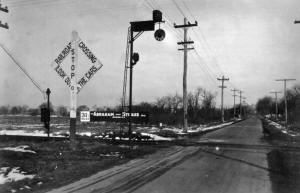
Broad Hollow Rd., Farmingdale - Diamond sign, Wig-wag, and bell -
View N 12/12/1928
Archive: Art Huneke |
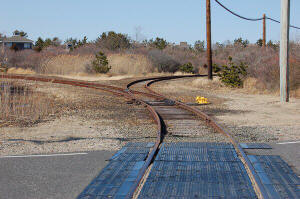
Unguarded rail crossing - Industrial Rd., Montauk wye 3/21/2008
Photo/Archive: Mike McDermet
|
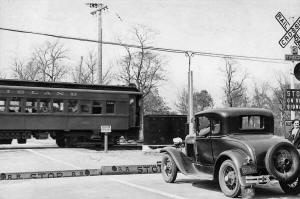
Hicksville Rd., Massapequa - Street barrier, crossbuck - Ford Model A
c.1931 View NE

RR STOP RR |
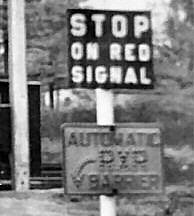
AUTOMATIC
RXR BARRIER
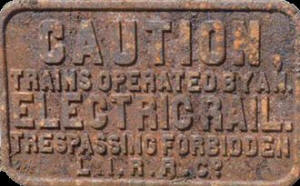
LIRR 3rd Rail Trespassing Forbidden sign |
|
|
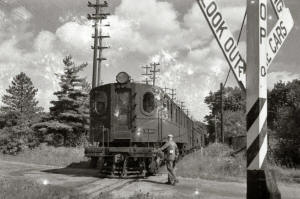
DD1 #358 The freight Brakeman is flagging the Cathedral Avenue crossing on
the West Hempstead Branch 9/28/1947
Photo: Ed Hermanns Archive: Dave Keller |
|
|
|
|
SIGNS |
|
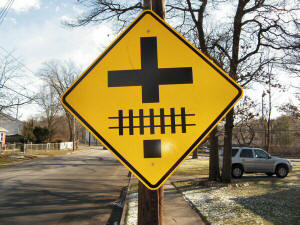
Central Branch crossing in West Babylon 1/29/2007
Photo/Archive: Al Castelli
W10-11 8B.24 Storage
Space Symbol
Should be used where there is inadequate
clear storage space between the crossing and
a downstream intersection, as determined by
engineering study
|

Low Ground Clearance Warning Sign
Oyster Bay Photo/Archive: Steven Lynch |
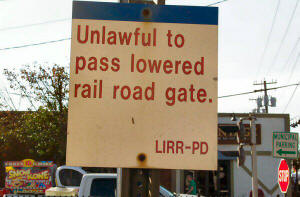
Unlawful to pass lowered rail road gate - LIRR police department.
Main St., Farmingdale 10/07/2017
Photo: Bill Mangahas |
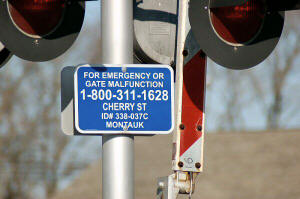
Emergency Notification Sign (ENS) sign Cherry Ave., Sayville
Photo/Archive: Steven LynchNote: Crossing
indicates Cherry St. in error. |
|
|
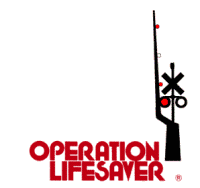 |
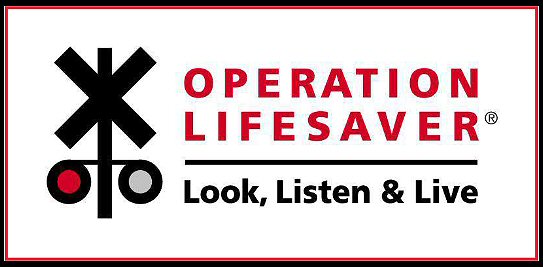
Operation Lifesaver - LIRR/MTA 2014 |
|